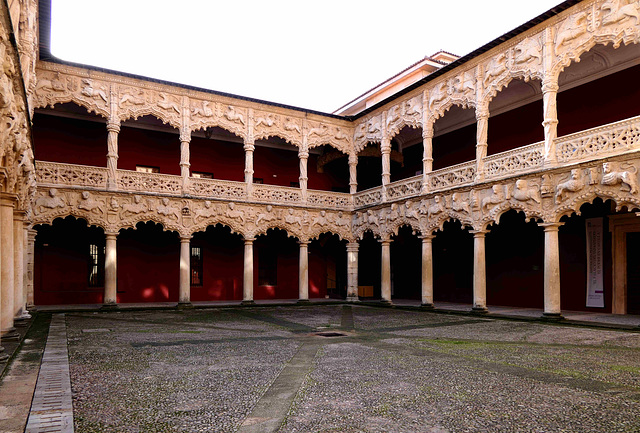Guadalajara - Palacio del Infantado
Alcalá de Henares - Museo de casa natal de Cervant…
Guadalajara - Santa María de la Fuente la Mayor
Medioevo a Santa Pau
Sigüenza - Catedral de Santa María
Tarragona, 3
Tarragona, 4
Sigüenza - Catedral de Santa María
Mojacar Andalucia Spain 12th November 2023
Calpe Valencia Spain 15th November 2023
Teruel - Aeroporto
Luco de Jiloca - Puente romano
Daroca - Puerta Baja
Teruel
Tarragona, 7
Salou (Tarragona), 45
Tarragona, 9
Tarragona, 12
Tarragona, 13
Valencia - Catedral de Santa María
Valencia - Plaza de Toros
Valencia - Estacion del Norte
Valencia - Plaza del Ayuntamiento
Torija - Castillo de Torija
Sigüenza - Castillo de Sigüenza
HFF Granada Spain 9th November 2023
Alhambra Granada Spain 7th November 2023
Granada Spain 6th November 2023
HWW Valencia Spain 15th November 2022
Salou (Tarragona), 44
Faro del cabo Salou, 1
Isaba (Navarra), 17
Salou (Tarragona), 35
Salou (Tarragona), 31
Salou (Tarragona), 29
Salou (Tarragona), 21
Salou (Tarragona), 20
HFF
Sant Pau
Salou (Tarragona), 19
Salou (Tarragona), 17
Salou (Tarragona), 16
Salou (Tarragona), 14
Salou (Tarragona), 13
VERDANT
Location
Lat, Lng:
You can copy the above to your favourite mapping app.
Address: unknown
You can copy the above to your favourite mapping app.
Address: unknown
See also...
Keywords
Authorizations, license
-
Visible by: Everyone -
All rights reserved
-
56 visits
Guadalajara - Palacio del Infantado


Guadalajara was first mentioned as an Iberian foundation, later it was a Roman settlement under the name Arriaca. The city was refounded by the Arabs as Wadi al-Hijara. During the Muslim period, an Alcázar was built by the mid-9th century. A bridge over the Henares River and the walls enclosing the city were also built by then.
Guadalajara was part of the territory annexed by Alfonso VI of León-Castile in 1085. The area was repopulated with people from the North. Alfonso VII granted Guadalajara its first chapter in 1133.
From 1441 to 1690 it was owned and controlled by the powerful Castilian noble house of Mendoza.
The "Palacio del Infantado" is located on the same site as the "casas principales" of Pedro González, the first Mendoza of Alcarreño. In 1480, the second Duke of El Infantado, Íñigo López de Mendoza, demolished the family's old house and decided to build a new palace "to increase the glory of his ancestors and his own." The facade was completed in 1483. In 1560, the wedding celebrations of King Philip II and Elizabeth of Valois took place in the palace.
In 1569, the fifth Duke del Infantado carried out a series of renovations to keep the palace on par with the residence of Philip II near Madrid. Therefore, some Renaissance elements were added to the facade.
In 1738, Maria Anna of Palatinate-Neuburg, the last Queen of the Spanish Habsburgs, retired from her exile in Bayonne to the Infantado Palace, where she died two years later.
The “Patio de los Leones” is the central courtyard. Pairs of lions were the emblem of Don Diego Hurtado de Mendoza.
The building was bombed and destroyed during the Spanish Civil War in 1936. Meanwhile, the dilapidated palace has been rebuilt and restored to return it to its former glory.
Guadalajara was part of the territory annexed by Alfonso VI of León-Castile in 1085. The area was repopulated with people from the North. Alfonso VII granted Guadalajara its first chapter in 1133.
From 1441 to 1690 it was owned and controlled by the powerful Castilian noble house of Mendoza.
The "Palacio del Infantado" is located on the same site as the "casas principales" of Pedro González, the first Mendoza of Alcarreño. In 1480, the second Duke of El Infantado, Íñigo López de Mendoza, demolished the family's old house and decided to build a new palace "to increase the glory of his ancestors and his own." The facade was completed in 1483. In 1560, the wedding celebrations of King Philip II and Elizabeth of Valois took place in the palace.
In 1569, the fifth Duke del Infantado carried out a series of renovations to keep the palace on par with the residence of Philip II near Madrid. Therefore, some Renaissance elements were added to the facade.
In 1738, Maria Anna of Palatinate-Neuburg, the last Queen of the Spanish Habsburgs, retired from her exile in Bayonne to the Infantado Palace, where she died two years later.
The “Patio de los Leones” is the central courtyard. Pairs of lions were the emblem of Don Diego Hurtado de Mendoza.
The building was bombed and destroyed during the Spanish Civil War in 1936. Meanwhile, the dilapidated palace has been rebuilt and restored to return it to its former glory.
kiiti, Alexander Prolygin, Paolo Tanino, appo-fam have particularly liked this photo
- Keyboard shortcuts:
Jump to top
RSS feed- Latest comments - Subscribe to the comment feeds of this photo
- ipernity © 2007-2025
- Help & Contact
|
Club news
|
About ipernity
|
History |
ipernity Club & Prices |
Guide of good conduct
Donate | Group guidelines | Privacy policy | Terms of use | Statutes | In memoria -
Facebook
Twitter

Sign-in to write a comment.